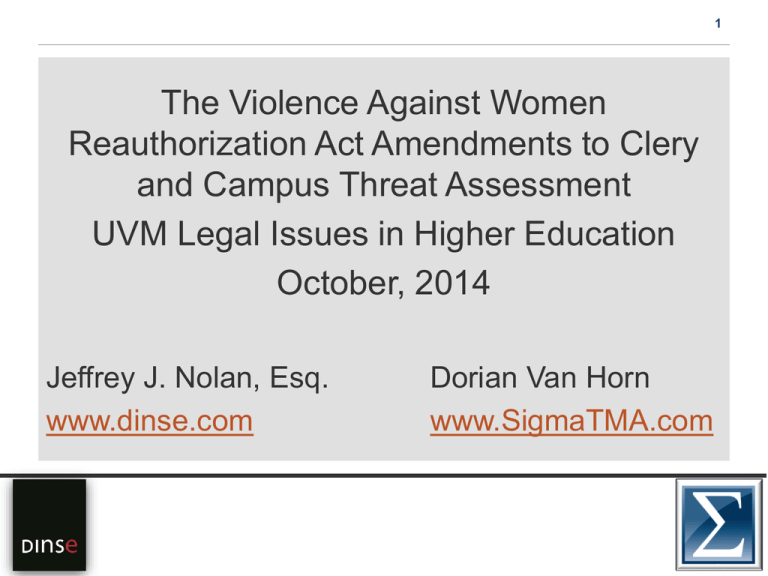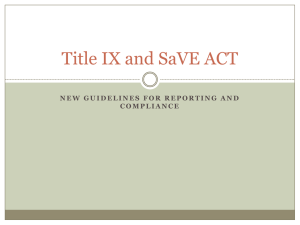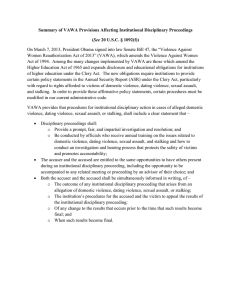
1
The Violence Against Women
Reauthorization Act Amendments to Clery
and Campus Threat Assessment
UVM Legal Issues in Higher Education
October, 2014
Jeffrey J. Nolan, Esq.
www.dinse.com
Dorian Van Horn
www.SigmaTMA.com
2
Speaker Introductions
Jeffrey J. Nolan, Esq.
Chair
Higher Education Practice Group
Dinse, Knapp, & McAndrew PC
(802) 864-5751
JNolan@Dinse.com
3
Speaker Introductions
Dorian Van Horn
Senior Consultant
Sigma Threat Management
Associates
DVanHorn@SigmaTMA.com
4
Agenda
VAWA/Clery Act amendment requirements
Addressing domestic violence, dating
violence, and stalking
Integrating campus threat assessment
strategies into VAWA Amendments-related
protocols
5
VAWA/Clery Act Amendment
Requirements
6
Violence Against Women Act (1994)
Designed to improve criminal justice response to
violence against women by, for example:
Strengthening federal penalties for repeat sex offenders
Creating a federal “rape shield law,” intended to prevent
offenders from using victims’ past sexual conduct against them
Strengthening victims’ ability to obtain/enforce protection orders
7
Violence Against Women Reauthorization
Act of 2013
Amends Higher Education Act/Clery Act “to improve
education and prevention related to campus sexual
violence, domestic violence, dating violence, and
stalking”
VAWA comes to campus/Title IX meets Clery
Effective March 2014/October 2014 ASR
See 20 U.S.C. § 1092(f)
8
New Policy Requirements
Each IHE receiving federal funding under HEA must
develop and distribute in its Annual Security Report
(“ASR”) a statement of policy regarding:
The institution’s programs to prevent domestic violence, dating
violence, sexual assault, or stalking; and
The procedures that the institution will follow once an incident of
domestic violence, dating violence, sexual assault, or stalking
has been reported
9
New Policy Requirements
Several specific procedural protections/statements must
be included in 2014 ASR
Some were derived or adapted from April 2011 DCL
Applicable to cases involving student AND employee
complainants
Institutions are adapting student and HR policies to
dovetail with ASR statements
10
New Policy Requirements
ASR must include statements that:
Covered disciplinary proceedings will provide a prompt, fair, and
impartial investigation and resolution
Such proceedings will be conducted by officials who receive
annual training on issues related to domestic violence, dating
violence, sexual assault, and stalking and how to conduct an
investigation and hearing process that “protects the safety of
victims and promotes accountability”
11
New Policy Requirements
ASR must state that both parties are entitled to same
opportunities to have others present during disciplinary
proceedings
“Including the opportunity to be accompanied to any related
meeting or proceeding by an advisor of their choice”
This includes legal counsel
Any appeals must be equally available to both parties
12
Educational Requirements
Campus SaVE requires description of education
programs to promote awareness of offenses of domestic
violence, dating violence, sexual assault, and stalking
Requirement includes several specific mandates of what
must be covered in:
“Primary prevention and awareness programs” for incoming
students and new employees
“Ongoing prevention and awareness campaigns for students
and faculty”
13
VAWA/Clery Definitions/Educational
Requirements
For Clery Act crime statistics reporting purposes,
“domestic violence” means crime of violence committed
by spouse, cohabitant, parent of victim’s child, or
similarly situated person
As relationships/protections are defined under state domestic or
family violence laws
However: look to state law definition for campus
educational program purposes
14
VAWA/Clery Definitions/Educational
Requirements
For Clery Act crime statistics reporting purposes, “dating
violence” means violence committed by a person
Who is or has been in a social relationship of a romantic or
intimate nature with the victim
Where the existence of such relationship is determined based on
consideration of:
Length and type of relationship and
Frequency of interaction between persons involved
Again, look to state law definition for campus educational
program purposes
15
VAWA/Clery Definitions/Educational
Requirements
For Clery Act crime statistics reporting purposes,
“stalking” means engaging in a course of conduct
directed at a specific person that would cause a
reasonable person to:
Fear for his or her safety or the safety of others; or
Suffer substantial emotional distress
Again, look to state law definition for campus educational
program purposes
16
State Criminal Law vs. Institutional Policy
Institutional policy definitions should control in
institutional disciplinary proceedings
VAWA/Clery requires that burden of proof be specified in
policy
OCR requires that burden in sexual assault cases be
“preponderance of the evidence”
“More likely than not”
To find responsibility, finding must be made that there is a more
than 50% likelihood that behavior in violation of policy occurred
17
VAWA/Clery Required Curricula
Education regarding “safe and positive options for
bystander intervention that may be carried out by an
individual to prevent harm or intervene when there is a
risk of” a covered offense against another person
Education regarding “information on risk reduction to
recognize warning signs of abusive behavior and how to
avoid potential attacks”
18
Title IX Enforcement Context
OCR:
Investigates individual complaints
Conducts agency-initiated compliance reviews
In theory, negative OCR findings can result in:
Loss of federal funding through Dept. of Education proceedings
or referral to DOJ for litigation
Practically, “voluntary” remedial actions are negotiated,
and become part of the evolving framework practitioners
work within
19
Clery Act Enforcement Context
Enforced by U.S. Department of Education’s Federal
Student Aid (FSA) Office
Department has ramped up enforcement activity
significantly
In 2008, Eastern Michigan University paid a record fine
of $350,000
Other six-figure fines have been levied since
In 2012, the per-violation fine amount was increased
from $27,500 to $35,000
20
Clery Act Enforcement Context
Department can base investigations on complaints from
individuals, or
Can choose to conduct a “program review’
Based upon violations noted in cursory checks
Media monitoring
Alleged under-reporting of sexual assaults is a matter of
particular interest to the Department
Alleged victims and victims’ groups have recently paired Clery
Act complaints with Title IX OCR complaints
21
Clery Act Enforcement Context
In October 2013, FSA fined Lincoln University $275,000
for various recordkeeping and policy statement violations
Included $27,500 fine for University’s failure to include
statement about potential sanctions for sexual assault in
its ASR
Program review documents can be found at
http://studentaid.ed.gov/about/data-center/school/cleryact
22
Clery Act Civil Action Issues
No private right of action under Act
“Nothing in this subsection may be construed to—
(i) Create a cause of action against any institution of higher
education or any employee of such an institution for any civil
liability; or
(ii) Establish a standard of care.”
20 U.S.C. § 1092(f)(14)(A).
23
Clery Act Civil Action Issues
“Notwithstanding any other provision of law, evidence
regarding compliance or noncompliance with [the Act]
shall not be admissible as evidence in any proceeding of
any court, agency, board, or other entity, except with
respect to an action to enforce [the Act].”
20 U.S.C. § 1092(f)(14)(B).
24
Standard of Care Issues
April 2011 DCL/April 2014 OCR Q&A?
April 2014 White House Not Alone documents?
Negligence?
Custom?
Lees v. Carthage College, 714 F.3d 516 (7th Cir. 2013)
25
Addressing Domestic Violence, Dating
Violence, and Stalking Situations
26
Domestic Violence Statistics
Most domestic violence incidents are never reported
Women ages 20 to 24 are at greatest risk of becoming
victims of domestic violence
One in 4 women will experience domestic violence
during her lifetime
Every year, 1 in 3 women who is a victim of homicide is
murdered by her current or former partner
Safe Haven 2012
27
Domestic Violence Statistics
2010 CDC National Intimate Partner and Sexual
Violence Survey (NIPSV) of 16,507 adults (9,086
women, 7,421 men) found:
Among those who experienced rape, physical violence, or
stalking by an intimate partner, more than 1 in 5 female victims
(22.4%) and more than 1 in 7 male victims (15%) experienced
some form of intimate partner violence for first time between
ages of 11 and 17
47.1% of female victims and 38.6% of male victims were
between 18 and 24 when they first experienced violence by an
intimate partner
28
Dating Violence Statistics
Girls and young women between 16 and 24 experience
highest rate of intimate partner violence (almost triple the
national average)
33% of teens disclosed violent relationship
Half of youth who have been victims of both dating
violence and rape attempt suicide, compared to 12.5% of
non-abused girls and 5.4% of non-abused boys
love is respect.org
29
Dating Violence Statistics
College Dating Violence and Abuse Poll, 2011
43% of dating college women report experiencing
some violent and abusive dating behaviors including
physical, sexual, tech, verbal, or controlling abuse
Over one in five college women (22%) report actual
physical abuse, sexual abuse, or threats of physical
violence
52% of college women report knowing a friend who
has experienced violent and abusive dating behaviors
including physical, sexual, tech, verbal, or controlling
abuse
30
Stalking Statistics
Persons aged 18-24 years experience the highest rate of
stalking
Three in 4 stalking victims are stalked by someone they
know
66% of female stalking victims and 41% of male victims
are stalked by a current or former intimate partner
One in 4 victims report being stalked through the use of
some form of technology (such as e-mail or instant
messaging)
Stalking Resource Center
31
Stalking and Intimate Partner Homicide
76% of female homicide victims had been stalked by
their partner
67% had been physically abused by their partner
54% of female homicide victims reported stalking to
police before they were killed by their stalkers
Stalking Resource Center
32
Obstacles to Seeking Help
College Dating Violence and Abuse Poll, 2011
58% of college students say they don’t know what to
do to help someone who is a victim of dating abuse
38% of college students say they don’t know how to
get help for themselves on campus if they were a
victim of dating abuse
More than half of all college students (57%) say it is
difficult to identify dating abuse
33
Integrating Campus Threat Assessment and
Management Into VAWA AmendmentsRelated Protocols
34
What Is Threat Assessment?
A systematic process that is designed to:
1
• Identify persons of concern
2
• Gather information/investigate
3
• Assess information and situation
4
• Manage the situation
35
Current Best Practices
Multi-disciplinary team
Authority to engage in threat assessment
Standard threat assessment processes and procedures
Resources and activities that support threat assessment
operations
36
Why Involve Campus Threat
Assessment?
Situations involving domestic violence, dating violence,
or stalking may pose an ongoing threat to:
Victims
Witnesses
Campus officials
Campus community generally
Involvement is consistent with best practices
37
Role of Campus Threat Assessment in
VAWA Amendments Situations
Role of campus threat assessment is to work alongside
Title IX/VAWA Amendments-related functions to:
Identify potential concerns
Gather information from multiple sources
Assess whether a threat is posed
Implement plans to reduce threat
Work directly with victims on safety planning
38
Ways to Foster Interaction With
Campus Threat Assessment
Include Title IX Coordinator as part of Campus Threat
Assessment Team
Include Title IX Coordinator, local law enforcement, and
others in threat assessment training
Hold regular information-sharing meetings (weekly, bimonthly) with campus threat assessment team members
to discuss areas of mutual concern
Goal is to prevent “silo-ed” information
39
Specialized Training for
Campus Threat Assessment Teams
With increase in reporting, threat assessment teams will be
called upon to assist administrators in assessing and
managing risk connected with dating violence, domestic
violence, and stalking cases
Threat assessment teams should seek training on
investigative, assessment, and management issues unique
to dating violence, domestic violence, and stalking
Institution should track such training as part of Clery
reporting
40
Training on Investigating
Domestic/Dating Violence/Stalking
If there is suspected strangulation, contact medical professionals
Strangulation has only recently been identified as one of the most lethal forms of
domestic violence.
Strangulation is, in fact, one of the best predictors for the subsequent homicide of
victims of domestic violence.
One study showed that “the odds of becoming an attempted homicide
increased by about seven-fold for women who had been strangled by their
partner” (Journal of Emergency Medicine, 2008).
Victims may have no visible injuries whatsoever, yet because of underlying
brain damage due to the lack of oxygen during the strangulation assault,
they may have serious internal injuries or die days, even weeks, later
(NFJC- Training Institute on Strangulation Prevention).
41
Training on Investigating
Domestic/Dating Violence/Stalking
Must utilize trauma-informed approach
Must understand victim responses to trauma
Must understand that some counterintuitive responses to
victimization are actually typical
Must understand ambivalence often inherent in context
of abusive personal relationships
Must also base each case on evidence presented
42
Training on Investigating
Domestic/Dating Violence/Stalking
Ask complainant what evidence she/he might have
Emails, text messages, photographs
Facebook
Medical
Witnesses
Ask about all prior concerns
Victims sometimes change their story—work as if the victim
is unable to contribute
Document everything—if you didn’t document, it didn’t
happen
43
Managing Investigations
Work with local/campus law enforcement
Meet with them before you have an issue
Understand there will be different standards
Understand what everyone needs—law enforcement will likely
want to conduct investigation prior to campus investigation
What can you provide to assist?
Taking interim measures on campus
If the situation gets more involved than you think you can deal
with—call in professionals—never worry about asking for help
44
Using Campus Threat Assessment to
Address Obstacles to Reporting
Students and/or employees may feel trapped by the
social networks and/or closed environment
Students may feel isolated from their personal support
networks and resources—
Away from home
International students could be particularly isolated
Due to combined residential/educational/social networks
of a college campus, it may be easier for abusers to
stalk/control their partner
45
Using Campus Threat Assessment to
Address Obstacles to Reporting
Campus threat assessment teams can help encourage
students and employees to report concerns about
domestic violence, dating violence, or stalking.
General awareness messages about reporting
threatening behavior can also address domestic/dating
violence and stalking.
Cross-referral mechanisms help ensure reports get to
the right team/entity.
46
Questions
47
Contact Information
Jeffrey J. Nolan, Esq.
Dinse, Knapp & McAndrew, P.C.
Sigma Threat Management
Associates
jnolan@dinse.com
www.dinse.com
Dorian Van Horn
Sigma Threat Management
Associates
DVanHorn@sigmatma.com
www.sigmatma.com


